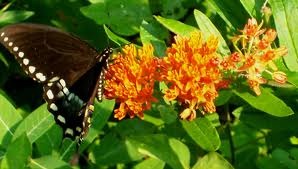Butterfly weed (Asclepias tuberosa) is a beautiful plant that will draw butterflies, bees, hummingbirds and other beneficial insects to your yard. Unfortunately, this plant is also attractive to pests like aphids. If you have butterfly weed in your garden you have probably noticed tiny, orange bugs on your plants. These orange aphids are known as oleander aphids (aphis nerii) or milkweed aphids and are commonly found on butterfly weed and other milkweed plants.
Description
-
The oleander aphid is orange-yellow in color with black legs and cornicles (tubular structures located on each side of the abdomen). The oleander aphid will expel honeydew or pheromones from these cornicles. It is believed that oleander aphids are all females and their reproduction is through cloning. The adults of this aphid variety may or may not have wings. Aphids drink sap from the host plant, which can lead to damage if the infestation is heavy.
Life Cycle
-
Adult oleander aphids are all female and do not lay eggs. Instead, the adult aphids deposit nymphs that are actually clones of the adults. Cloning reproduction in this manner allows the oleander aphids to create a large population of aphids on a plant in a short amount of time.
Location
-
Oleander aphids can be found in warm regions all over the world and are believed to have originated in the Mediterranean region. Because oleander aphids are attracted to varieties of milkweeds (which includes butterfly weed), these orange bugs can be found wherever such plants are found.
Plant Preferences
-
The preferred plants for the oleander aphid are oleander, wax plant and all varieties of milkweed plants. When oleander aphids feed on butterfly weed, the bugs can usually be found in concentrations around the top of the plant at the flower stems. On the butterfly weed, the aphids will congregate on any part of the plant. Oleander aphids are attracted to the young spring buds, leaves and shoots.
Damage
-
Oleander aphids are not especially damaging to the health of the butterfly weed. Heavy infestations of aphids on butterfly weed can cause injury, but generally the bugs do not cause much damage to the health of the plant. Aphids will expel a sticky substance called honeydew that can cause sooty mold. The sooty mold can be unsightly on the plant. If the infestation of aphids is very heavy, the result can be stunted growth and deformed new growth on the plant.
Natural Predators
-
The oleander aphid has natural predators that can aid in control of the bugs. These predators include certain fly larvae, parasitic wasps and certain beetles. Beetles like the ladybird beetle or ladybug will feed on the aphids. The parasitic wasp Lysiphlebus testaceipes lays eggs in the aphid’s body and the emerging young wasps cut a hole in the abdomen of the aphids. Infested aphids will swell then turn brown before they die.


Deprecated: strpos(): Passing null to parameter #1 ($haystack) of type string is deprecated in /home/agriviek8Qv/agriviet.net/public_html/wp-includes/comment-template.php on line 2522